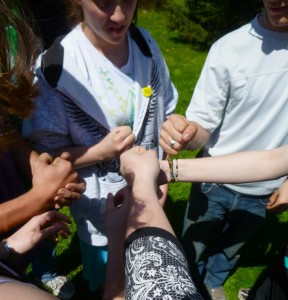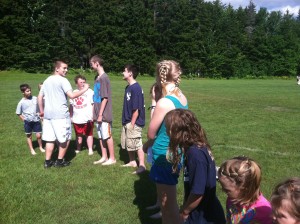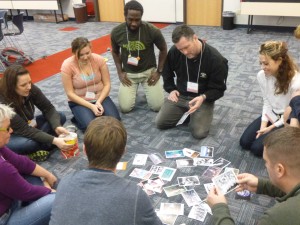
Jan 15, 2013 From the Archive: The Disappearance of Neighborhood “Pick Up” Games and the Importance of Collaborative Learning
In April 2010 I posted “The Disappearance of Neighborhood Games of “Kick the Can” and “Kickball” and it’s Impact on Learners”. This discussion has continued to come up in my workshops over the years, especially in my recent work with advisory group leaders and after school program staff. Tonight I am reposting the article to begin a series of posts on the power of play and the value of collaborative approaches to teaching.

In my work with students of all ages in a variety of schools and treatment programs, I notice that many increasingly seem to struggle with group communication, decision-making, and conflict resolution. On the playground during recess I observe elementary and even middle school students coming to teachers to resolve the simplest disagreements or conflicts- for instance, who is going to be “it” first in a one on one tag game. Similarly, many of my high school and college students struggle with group projects and the skills of group decision-making, empathy, and collaborative problem solving.
Youth often depend on teachers and other adults to pick teams for games, decide who should go first, or to resolve basic conflicts situations in group work and play. These are decisions that I remember sorting out with my peers on our own (most of the time) during our pick up games of “kick the can”, kick-ball and other games we played in our neighborhood or on the school playground.

After seeing this trend in so many of the youth and young adults I work with over the years, I started realizing this behavior might be influenced by the fact that many youth in today’s society didn’t, or don’t, have the same opportunity to engage in the unsupervised free play with peers that many of us adults who grew up in the 60’s 70’s and 80’s. There were more opportunities for free play during school time. It was common for children to roam the neighborhood with other kids of various ages playing group games from early morning to dusk in the summertime and regularly after school with little to no adult intervention.
Our society is becoming increasingly isolative. Children aren’t out playing pickup games in their neighborhoods during free time after school (if they even have it), or on summer evenings as they once did. Parents are often fearful about letting kids play and roam the neighborhood on their own. In many schools recess or unstructured break time has shortened or dwindled completely.
Children and adolescents participate in a great deal of solo video and computer games, and activities. These can be great tools for learning but also can take them away from positive social interaction. Most often children’s group recreation these days involves team sports, clubs, and after school programs led by adults and separated by ages. There is obviously great value in structured team and after school programs, and a benefit to having excellent adult role models that positively impact students through these programs.
A downside of this shift is that youth are not gaining the important skills that are learned from interaction with peer only groups without adult intervention. They miss out on opportunities to practice being flexible and making compromises with each other in order to make a game work and learning that play is not always “getting their way” or winning. In peer only activities with little or no adult intervention kids gain valuable experience in coming to consensus on the rules of play, decision-making, and developing social skills around communication and conflict resolution.

As a kid I experienced many opportunities for unstructured play in our neighborhood; multi-age pickup games of all kinds filled our summer days and after-school hours. Arguments about who was “it” or who won inevitably arose, but most of the time we figured out ways to work it out ourselves rather than interrupt the game to run home and get an adult to decide for us. Older children taught younger children “rules of play” and acted as caretakers and role models.
It appears that in modern society with less participation in peer-only play, kids are missing out on opportunities to gain important conflict resolution, problem solving and group communication skills. We can help learners gain these skills by providing opportunities within our structured programs to practice decision making and communication on their own.

To integrate this kind of skills building in both my classroom programs with youth and my training work with adults, I intentionally started focusing on implementing participant directed activities that practice the use of decision-making by consensus. I try to give less direction in activities and challenges and put more responsibility on the group members for defining goals, parameters and decision-making (see Educator as Guide article). In after school programs and in family night and field day sessions I try to promote multi-age games sessions so older students can teach and mentor younger students. With all age groups I purposefully create situations and opportunities that allow participants to practice coming to agreement on the rules of the game, a team name, a team symbol etc. I use methods that involve pairs and then in groups to make simple choices together and work up to practicing group consensus. This is a valuable practice/lesson for groups of all ages. Our rapidly changing society and work world is requiring people to be problem-solvers, communicators and collaborators. Group challenges, collaborative problem-solving activities, and cooperative projects are valuable teaching tools for the 21st century.
In yesterday’s post I shared one of my favorite collaborative problem-solving activities “Fill the Crate”. In past posts we explored combining collaborative problem solving with academic review strategies to make the most of your time in classroom and training situations. These activities practice community building and social emotional learning while reinforcing academic content see May’s post “Play Dough Pictionary” Charades Race, and September’s post Zoom and Other Sequencing Challenges.
In upcoming posts we will continue to explore the power of collaborative learning and playful approaches to teaching and group facilitation. These include articles on research from the emerging field of educational neuroscience that supports these approaches as well as more activities and strategies.



No Comments